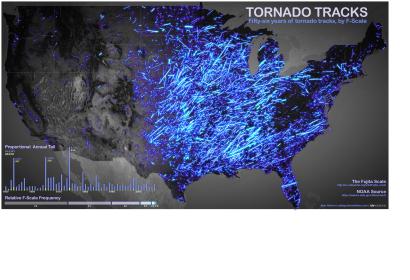On 29 April 2014, a new animation of the storm system which spawned 31 tornados affecting seven states across the Central and Southern United States from 27 to 28 April 2014 has been released by NASA using data collected from a NOAA’s GOES East Satellite and NASA’s Aqua Satellite. This data coupled with local weather observations and computer models is able to give forecasters real time information about developing weather situations.
The animation has a run time of 31 seconds. It begins on 26 April 20:15 and runs till 10:15 28 April (local time). The animation illustrates the development and tracks the movement of the storm front.
In order to create the video imagery, NASA and NOAA’s Geostationary Operational Environmental Satellite project (GOES) gather infrared imagery from clouds and overlay this data on true color images created by NASA’s Aqua and Terra Satellites equipped with Moderate Resolution Imaging Spectroradiometer (MODIS) instruments. The overlaid images create complete the picture of the storm system and track its movements.

